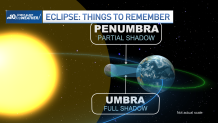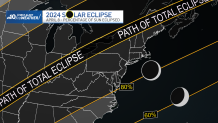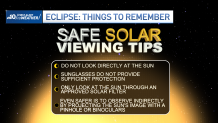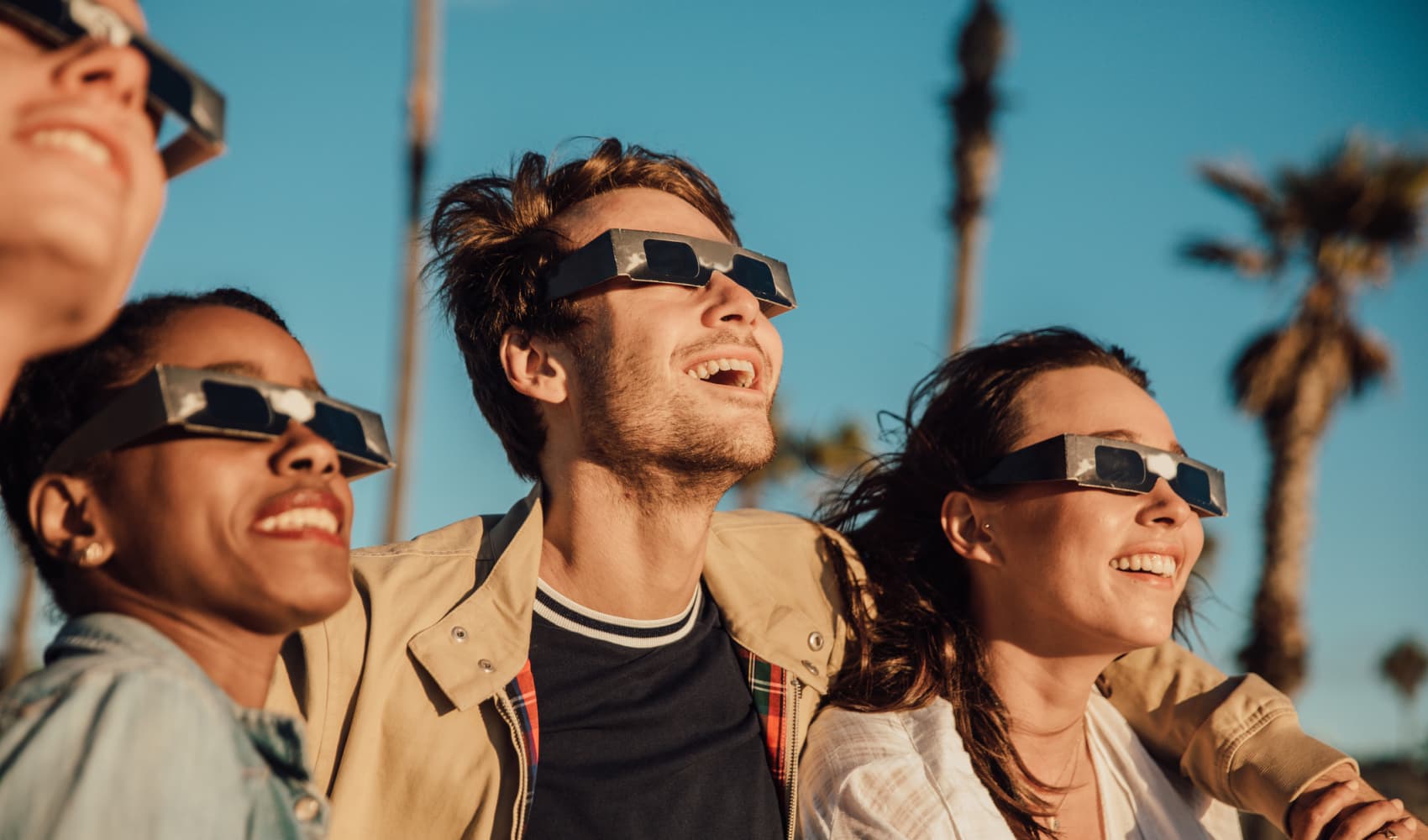What to Know
- A total solar eclipse will be visible across the United States from Texas to Maine on April 8, 2024.
- In Philadelphia, the eclipse will reach nearly 89% coverage at its afternoon peak.
- Be sure to only view the eclipse with proper eye protection. "Snag some special solar glasses or use a pinhole projector," NBC10 First Alert Weather meteorologist Bill Henley said.
A solar eclipse is set to occur on April 8, 2024 and it can be viewed across the United States, including Philadelphia, Pennsylvania, South Jersey, and the surrounding communities!
Here’s everything you need to know about the rare celestial event and what we will be able to see in the Delaware Valley.
What is a total solar eclipse?
Get Philly local news, weather forecasts, sports and entertainment stories to your inbox. Sign up for NBC Philadelphia newsletters.
A solar eclipse occurs when the moon comes between the earth and the sun. During a total solar eclipse, the moon blocks the light coming in from the sun and appears to cover up the sun entirely. This will give viewers a glimpse of the sun’s outer atmosphere, known as the corona.
“Amazing things happen too,” NBC10 First Alert Weather meteorologist Justin Godynick said. “Animals that are normally coming out at night begin to come out during the eclipse. Crickets will start to chirp and it gets colder because the sun is (blocked).”
Observers of a partial eclipse view the penumbra in which only a portion of the light source is obscured by the occluding body. The umbra is the innermost and darkest part of a shadow in which the light source is completely blocked by the occluding body.

When was the last time we had a solar eclipse?
The last total solar eclipse visible over the Continental United States was on Aug. 21, 2017. That eclipse covered a more rural area with only 12 million people in the path of totality. This upcoming eclipse will be visible from Mexico, the U.S. and Canada to an estimated 31.6 million people and will cover more densely populated areas, including Dallas, Texas and Cleveland, Ohio.
What will happen on April 8, 2024?
The new moon will appear to cover the sun’s disk in parts of Mexico, the U.S. and Canada. In some areas, there will be a total solar eclipse while in other areas, there will be a partial solar eclipse.

When and where can you see the total solar eclipse?
The total solar eclipse will be visible in the following areas for the following durations on April 8, 2024, according to Space.com:
| Mazatlán, Sinaloa, Mexico | 11:07 a.m. MST | 4 minutes 20 seconds |
| Durango, Durango, Mexico | 12:12 p.m. CST | 3 minutes 50 seconds |
| Torreón, Coahuila, Mexico | 12:16 p.m. CST | 4 minutes 11 seconds |
| Piedras Negras, Coahuila, Mexico/Eagle Pass, Texas, U.S | 1:27 p.m. CDT | 4 minutes 24 seconds |
| Kerrville, Texas, U.S | 1:32 p.m. CDT | 4 minutes 25 seconds |
| Fredericksburg, Texas, U.S | 1:32 p.m CDT | 4 minutes 25 seconds |
| Dallas, Texas, U.S | 1:40 p.m. CDT | 3 minutes 52 seconds |
| Idabel, Oklahoma | U.S: 1:45 p.m CDT | 4 minutes 19 seconds |
| Russellville, Arkansas, U.S | 1:49 p.m. CDT | 4 minutes 12 seconds |
| Cape Girardeau, Missouri, U.S | 1:58 p.m. CDT | 4 minutes 7 seconds |
| Carbondale, Illinois, U.S | 1:59 p.m. CDT | 4 minutes 10 seconds |
| Bloomington, Indiana, U.S | 3:04 p.m. EDT | 4 minutes 3 seconds |
| Indianapolis, Indiana, U.S | 3:06 p.m. EDT | 3 minutes 51 seconds |
| Cleveland, Ohio, U.S | 3:13 p.m. EDT | 3 minutes 50 seconds |
| Erie, Pennsylvania | U.S: 3:16 p.m. EDT | 3 minutes 43 seconds |
| Rochester, New York, U.S | 3:20 p.m. EDT | 3 minutes 40 seconds |
| Montpelier, Vermont, U.S | 3:27 p.m. EDT | 1 minutes 42 seconds |
| Oakfield, Maine, U.S | 3:31 p.m. EDT | 3 minutes 23 seconds |
| Niagara Falls, Ontario, Canada | 3:18 p.m. EDT | 3 minutes 31 seconds |
| Montreal, Quebec, Canada | 3:26 p.m. EDT | 1 minute 57 seconds |
| Miramichi, New Brunswick, Canada | 4:34 p.m. ADT | 3 minutes 8 seconds |
| Tignish, Prince Edward Island, Canada | 4:35 p.m. ADT | 3 minutes 12 seconds |
| Catalina, Newfoundland, Canada | 5:13 p.m. NDT | 2 minutes 53 seconds |
When and where can you see the most of the solar eclipse in Philadelphia, other cities?
"Many people will be traveling to view the total solar eclipse, but those staying close to home in the Philadelphia area can still enjoy a significant spectacle with near 90% coverage of the eclipse, 88.8% in the city, to be exact," NBC10 First Alert Weather meteorologist Bill Henley said.
A partial solar eclipse will be viewable in the following locations for the following durations on April 8, 2024, according to Space.com.
| City | Percentage of sun covered | Time (local) |
| Mexico City | 74% | 12:14 p.m. CST |
| Tijuana | 54% | 11:11 a.m. PDT |
| Puebla | 70% | 12:15 p.m. CST |
| New York | 90% | 3:35 p.m. EDT |
| Los Angeles | 49% | 11:12 a.m. PDT |
| Chicago | 94% | 2:07 p.m. CDT |
| Houston | 94% | 1:40 p.m. CDT |
| Phoenix | 64% | 11:20 a.m. MST |
| Philadelphia | 88.8% | 3:23 p.m. EDT |
| San Antonio | 99.9% | 1:34 p.m. CDT |
| San Diego | 54% | 11:11 a.m. PDT |
| San Jose | 35% | 11:13: a.m. PDT |
| Toronto | 99.9% | 3:19 p.m. EDT |
| Calgary | 26% | 12:43 p.m. MDT |
In Philadelphia, the eclipse will occur from 2:08 p.m. until 4:35 p.m., peaking at 3:23 p.m., according to NASA's eclipse website.
"Even areas farther from the path of totality, like Cape May, will experience around 85%, while those closer, such as Allentown, will enjoy 91.4% coverage," Bill said.
What will the weather be in Philadelphia during the April 8, 2024 solar eclipse?
The key factor for witnessing any eclipse is visibility, will skies be clear enough to see it?
"Fortunately for the Delaware Valley, all the clouds and rain we are experiencing now will clear before the weekend," Bill said, "setting us up for good eclipse viewing conditions Monday, when are expected to be partly sunny during the eclipse in the afternoon."
How to safely watch the solar eclipse

Here are important safety tips to remember while viewing the eclipse:
Do not look directly at the sun
Sunglasses do not provide sufficient protection
Only look at the sun through an approved solar filter
An even safer practice is to observe indirectly by projecting the sun’s image with a pinhole or binoculars. You can also use welder’s googles or mask.
Listen to Uncle Bill Henley on this one:
"Just remember, for safe eclipse viewing, snag some special solar glasses or use a pinhole projector. Never look directly at the sun without proper eye protection!"
When will the next total solar eclipses be?
The next total solar eclipses over the United States will occur on March 30, 2033, in Alaska, and Aug. 23, 2044, over Canada and the U.S. (Montana, South Dakota, North Dakota). So take advantage of this rare event as you have the chance.
Sign up for our Breaking newsletter to get the most urgent news stories in your inbox.




